Hi guys I have noticed that Warren from NQ Explorers, who is an avid Garrett user is one of the guys in the video. You could probably check out his youtube site and ask him what he thinks. It is a good site for relic hunting videos and he is very experienced. Cheers, Rick
You are using an out of date browser. It may not display this or other websites correctly.
You should upgrade or use an alternative browser.
You should upgrade or use an alternative browser.
Garrett Extreme
- Thread starter Nugget
- Start date

Help Support Prospecting Australia:
This site may earn a commission from merchant affiliate
links, including eBay, Amazon, and others.
Hi guys, I asked Warren from NQ Explorers for some feedback and this is his reply.
This is the response to your request on the new ATX - fine to share this on the forum if you like mate - I have cleared it with Garrett.
Rick,
We were privileged to be involved with the Garrett team field testing the new ATX Pulse Induction metal detector in Australia.
This is a fantastic new piece of kit - built to military specifications (note that it is not the AML-1000, it just utilises the same casing). It has been tested and tuned in Australia by the Garrett Engineers, with particular attention to smooth performance in highly mineralized Aussie soils that we typically encounter in our goldfields.
The unique new design of the stock DD provides a really sensitive 'hot spot' on the coil for detecting very small gold. All in all a very rugged, quality build that will be great in our goldfields - particularly with the larger 20" monoloop coil which can cover a lot of ground when prospecting. The unit is well-balanced even with the big coil - it comes with a bungee sling so is very easy to swing.
The ATX is fully waterproof so keep detecting when it is raining - and economical to operate with the 8 AA batteries. It has a built-in speaker or you can use the headphones if you so desire. There will be more videos of the ATX coming soon with further details.
Happy Prospecting Everyone!
NQ Explorers
Warren and Colleen.
This is the response to your request on the new ATX - fine to share this on the forum if you like mate - I have cleared it with Garrett.
Rick,
We were privileged to be involved with the Garrett team field testing the new ATX Pulse Induction metal detector in Australia.
This is a fantastic new piece of kit - built to military specifications (note that it is not the AML-1000, it just utilises the same casing). It has been tested and tuned in Australia by the Garrett Engineers, with particular attention to smooth performance in highly mineralized Aussie soils that we typically encounter in our goldfields.
The unique new design of the stock DD provides a really sensitive 'hot spot' on the coil for detecting very small gold. All in all a very rugged, quality build that will be great in our goldfields - particularly with the larger 20" monoloop coil which can cover a lot of ground when prospecting. The unit is well-balanced even with the big coil - it comes with a bungee sling so is very easy to swing.
The ATX is fully waterproof so keep detecting when it is raining - and economical to operate with the 8 AA batteries. It has a built-in speaker or you can use the headphones if you so desire. There will be more videos of the ATX coming soon with further details.
Happy Prospecting Everyone!
NQ Explorers
Warren and Colleen.
GeoKJP
Kris J. Parker
- Joined
- Feb 24, 2013
- Messages
- 36
- Reaction score
- 1
I like the ruggedness and obvious build to be "soldier proof". I, for one, am taken by the look. It is sleek, clean and pretty robust looking. Would be keen to see how it handles Victorian dirt. An interesting bit of kit. Still keen on the ATX though...
The big question for 2013 will be the independant non - dealer affiliated person who gets one and runs it side by side with a GPX5000
20,000 people around the country will be keen to jump all over that assessment when it happens 8)
20,000 people around the country will be keen to jump all over that assessment when it happens 8)
- Joined
- Sep 19, 2013
- Messages
- 1
- Reaction score
- 0
It looks like the Garrett ATX is doing well in red mineralized dirt. This came off Facebook.
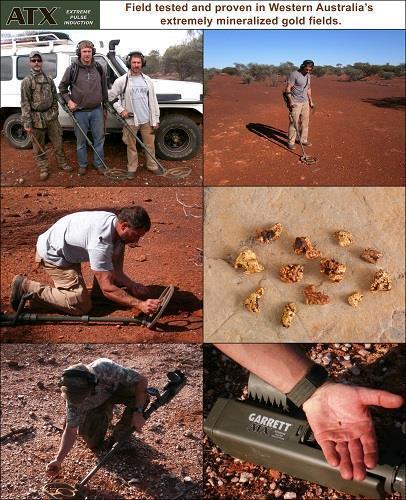

- Joined
- Feb 26, 2013
- Messages
- 3,271
- Reaction score
- 4,827
I sorta understand but not.HeadsUp said:and runs it side by side with a GPX5000
You cannot compare a Ferrari with a Monaro, the cost difference is quite substantial.
Toysandthings
Toys and things
- Joined
- May 2, 2013
- Messages
- 160
- Reaction score
- 60
Interesting street price compared to current and Garrett in the US prices.
But anyways.
Toys and Things in wollongong is offering 15% discount on pre orders only for the Garrett ATX PI.
Only for pre orders.
Is a hefty discount.
The more people we have with this detector reporting on it the better.
Cheers.
Lee.
But anyways.
Toys and Things in wollongong is offering 15% discount on pre orders only for the Garrett ATX PI.
Only for pre orders.
Is a hefty discount.
The more people we have with this detector reporting on it the better.
Cheers.
Lee.
nickel1500 said:It looks like the Garrett ATX is doing well in red mineralized dirt. This came off Facebook.
https://www.prospectingaustralia.co...ges/1378/1379544416_garrett_atx_australia.jpg
I would like to hear from someone that has actually used this machine on our forum before I would make any judgements. it looks good, but does it work as well as they say????
BrisJoe
Joe
So ant deffinate price range from the dealers on here?
petesabout
pete
- Joined
- Sep 22, 2013
- Messages
- 38
- Reaction score
- 8
well, i'm moving from California USA in April to Melbourne, i may have some room going spare in the shipping container 
I have a friend who purchased a detector in the states , travelled around a bit there and then came back to australia .
she was told the warranty would be transferable to whatever country she was in.
she was told the warranty would be transferable to whatever country she was in.
petesabout
pete
- Joined
- Sep 22, 2013
- Messages
- 38
- Reaction score
- 8
Here's the USA Pre-Order Price.......... $2,120.75 fitted with the 10x12 inch DD search coil = 2,262.95 $AU
ATX Deepseeker package comes with 10x12 inch DD & 15x20 mono coil.... $2,546.56 = 2,706 $AU
Deepseeker ATX 15x20" Mono coil pre-order price....$509.96 = 544.39 $AU
8" ATX Mono Searchcoil Pre-Order Price.... $450.46. = 480.85 $AU
This machine needs to be good to warrant the price of those coils
ATX Deepseeker package comes with 10x12 inch DD & 15x20 mono coil.... $2,546.56 = 2,706 $AU
Deepseeker ATX 15x20" Mono coil pre-order price....$509.96 = 544.39 $AU
8" ATX Mono Searchcoil Pre-Order Price.... $450.46. = 480.85 $AU
This machine needs to be good to warrant the price of those coils
petesabout
pete
- Joined
- Sep 22, 2013
- Messages
- 38
- Reaction score
- 8
mbasko said:Diggerdude said:HeadsUp said:pity i didnt wait 3 months before i bought a new GPX5000
The GPX's second hand resale prices will probably fall if the Garrett turns out to be that good
I reckon your safe there mate, Minelabs have always had great resale value. You can still get $2000 for a 20 year old one.
DD
No other PI released (Infinium, TDI) has reduced the resale on Minelab's yet & can't see that changing with the ATX. They will sell but dedicated gold searchers will still go for the GPX IMO. Unless the ATX gets into the field with some mind blowing result's I will still be aiming at an upgrade to a GPX4500 or 5000 in 9-12 months time.
If your gonna lower the resale on yours let me know then :lol:
p.s. Definitely hasn't happened yet - a nice used GPX5000 went for $6200 on eBay last night!
The counterfeits are knocking the used market for gpx5000 big time here, with the average selling for somewhere between $3500 us - $3800 us.
I'm actually waiting to see a listing crop up on Fleebay, where some dodgy chinese guy has chucked some dirt and sand over a new Alibaba.com knockoff and call it used.
Most of these sellers have new id's with little or no feedback. They will also have selling limits,so can't list a brand new gpx at a realistic price, hence they always start the listing from a dollar. If i was a low down,desperate, crime infested snake in the grass, i know which route i'd take. Fortunately for us, they aren't intelligent enough,get greedy and the listing gets reported and removed.
I spoofed a listing last week, giving out a list of "unscrupulous" sellers for 99 cents and was attacked from all sides by the Chinese triad. Quite funny really as my list grew 10 fold overnight and i made $18
Rant over, now where were we?..............Garrett Atx wasn't it
BrisJoe
Joe
Here are some testing results from another forum of mine in the states..
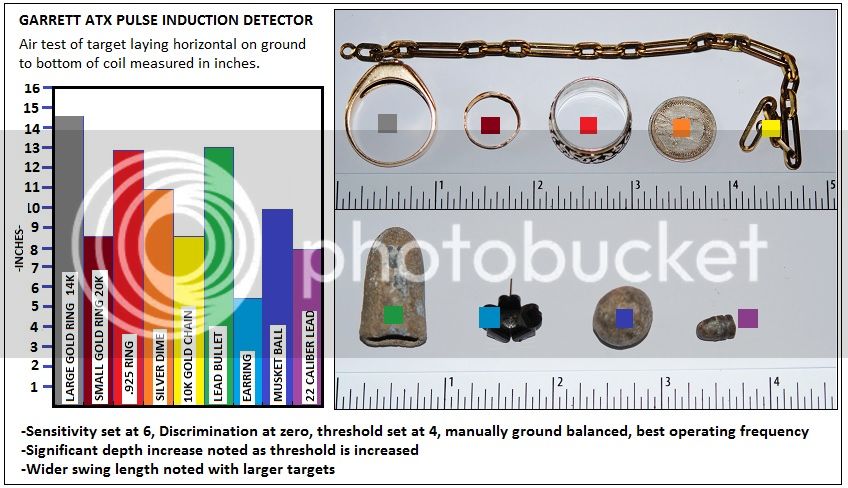
My first type of air test consisted of placing the target on the ground, with the shown settings of discrimination and threshold, with the discrimination setting set at zero. To maintain a certain level of reliability, I performed the test wearing sweat pants, T-Shirt, no rings, wallet, belt, watch with empty pockets and shoes with no metal. The measurements were taken from a static fixture, my leg, where the horizontal coil would barely yet audibly get a reading from the target lying horizontal on the ground, on an area free of any metal. I have fairly neutral ground, consisting of a humus layer in the upper stratus of about 3 inches, with clay below. The test was taken in my backyard, about 25 feet from my house. I had to deal with a large amount of EMI, having to retune the ATX at times to quiet it down. As previously mentioned, I measured the audio barely audible however still repeating against the still audible EMI. As predicted, the large gold ring managed to get the greatest depth. My understanding of the ATX platform is that it was specifically tweaked for gold. The other gold ring, considerably smaller in mass and diameter, also fared well. My favorite target for depth testing is a small lead 22 projectile, which came in at about 8 inches, with a sensitivity set at 6, possible max out at 13 and a threshold setting at 4 with a possible max also at 13. Running both these settings any higher just made the ATX too unstable at it's location. And, as a typical household, we own a couple large screen TV.s, cable, wi-fi for computer and cell phones.
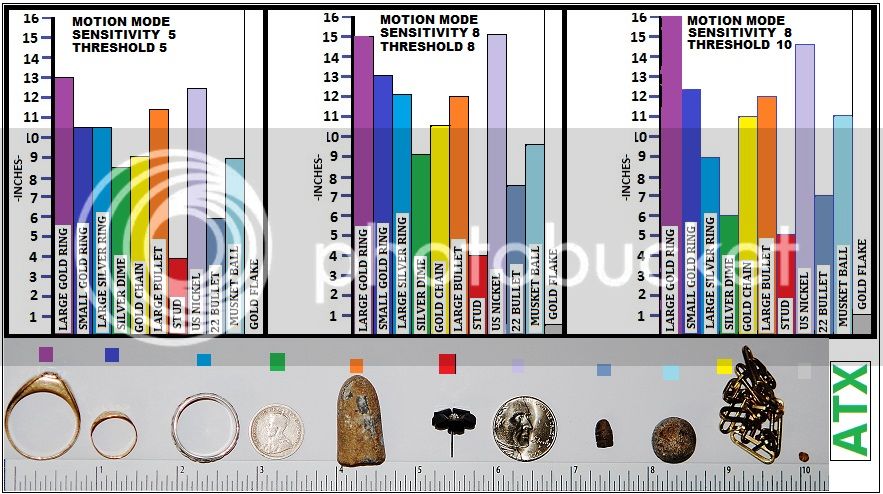
This second test was was again performed in my back yard, only I moved the test away from the house another 10 feet. And again to maintain a certan level of reliability, I performed the test wearing sweat pants, T-Shirt, no rings, wallet, belt, empty pockets and shoes with no metal. What made this test different from the one above, is that instead of placing the target on the ground, I performed strictly an air test, measuring the distance between the coil and target, with no matrix past the coil except air. I was curious as to the amount of EMI present. As it turned out, the EMI was slightly less, however probably due to the air tests being performed further away from the source (house). One purpose of the test was to show the difference in depth with an increase of threshold on the ATX. The increase of threshold from eight to 10 while still maintaining a sensitivity of 8 showed about 1 inch increase with the large gold ring, 1 inch increase on the nickel and a doubling of depth on the small fleck of goldfrom 0.5" to 1". That fleck of gold is so tiny it won't read on my electronic weigh scale set in grams. I included a nickel in my air tests this time, as a nickel can be a good indicator for a piece of gold, and I also wanted to see how it would read, assuming that the ATX was tweaked for gold. The results are quite interesting, when comparing all the targets against each other.
Please remember......these are air tests, and your reading for depth in the ground will deviate from my results, based on ground conditions, water, moisture, target size, EMI, coil used, and how the machine is programmed. Air tests are useful for comparisons of settings against a target, and also comparisons against numerous targets, under different conditions.
------------------------

I have been here many times, with a lot of my buddies. We have pretty well cleaned it out of rings, old coins, lighters and junk. The last two times I hunted here, I used the Infinium, and even then, my last hunt I got zip. However, it's getting cold up here, and freeze-up is weeks away, so I thought I would do some land hunting. Most of my time so far with the ATX has been mostly in the water, with great success. I concentrated mostly in the shrubs and bushes, the spots others often times ignore.
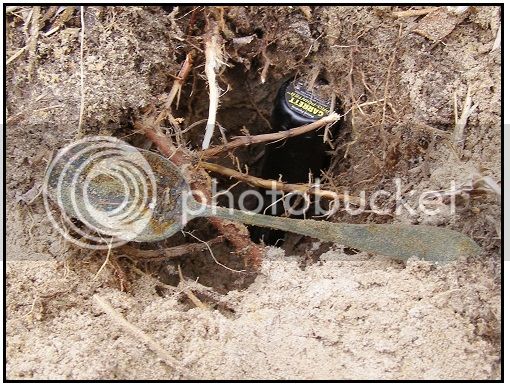
My first good signal was a deep spoon, down about 12 inches. At least I was in an area where people were picnicking some 100 years ago.
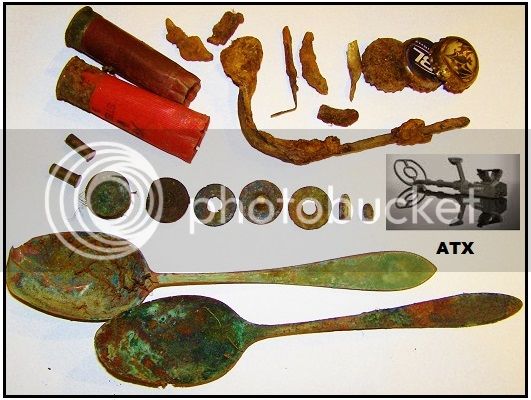
Here's the total finds for the day. Lots of old shotgun shells, some iron, typical of PI.s, very deep too. The smaller 22 lead bullet was down about 6 inches, and gave a nice soft high-low. The larger one was a bit shallower.
---------
I have been doing some of fieldwork recently testing the new Garrett ATX metal detector. It was used both on land and freshwater. My initial thoughts on the new Garrett ATX PI (Pulse Induction) metal detector were quite remarkable. Now I have been using the Infinium (also a PI) since 2007 and also used the Garrett Sea Hunter Mark II for some time. They have each rewarded me with lots of gold/silver rings, jewelry and lots of coins. The new ATX is a much improvement over the Infinium. I was amazed at how well it responded to tiny conductors. Many a 22 shell/bullets and small buckshot slipped through my water scoop holes, located from decent depths. Using the 12" coil, it also responded well to various chains which I also dug from the fresh water lakes. I did manage one thin gold chain, the one shown below beside the gold ring.
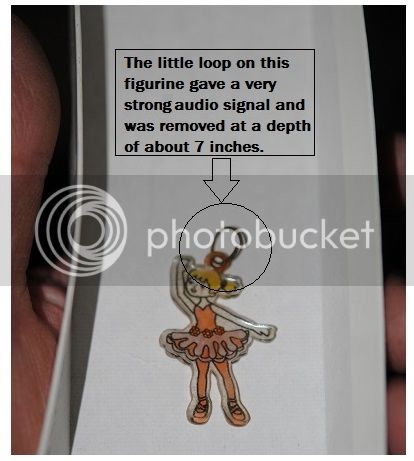

That smaller coil based inside the larger coil 12" coils are both DD coils. I've been told that they both work together to respond to tiny conductive targets.
I also noticed an improvement in depth using the 12" coil on the ATX compared to the Infinium using the 10" x 14" mono coil. As my initial experience several years ago, going from a VLF water machine to a PI, I discovered a whole new crop of rings, coins, jewelry and also junk that were now available to me that other people using VLF detectors just could not reach. I had a record year that year using both my Infinium and other VLF water machines. Now with the ATX, I also ran into a similar scenario. I again found a new crop of coins, rings and junk at even deeper depths then the areas I hunted using my Infinium. Now in all honesty, the new crop was not as fruitful as when I internally used the Infinium, but the improvement was definitely there. I had to wait until the swimming was over for the summer to hunt most of my water locations, as the holes I had to dig with my scoop were very deep, and no matter how hard I try, I never seem to be able to get those deep holes filled in completely, so I opted to wait.
Now the ATX utilizes an iron check completely different from the Infinium. With a push of a button, running the coil over an unknown iron target will give a low audio similar to the iron audio featured on the AT Series. The ATX gave that iron response on bottle caps, large nails, rusty cans, metal washers and some recent Canadian clad. It is limited to depth, and seemed to work quite well on bottle caps to about 4 inches, more on tin cans and variable results with nails. It's up to the user to learn the limitations of this feature. I didn't use the discrimination mode at all, as it is one typical of PI's, in that it can be used to stabilize the detector in certain environments. It should not to be used to knock out certain targets, as you begin to loose depth as you increase the discrimination.
-----
Just food for thought for those considering buying the machine.
My first type of air test consisted of placing the target on the ground, with the shown settings of discrimination and threshold, with the discrimination setting set at zero. To maintain a certain level of reliability, I performed the test wearing sweat pants, T-Shirt, no rings, wallet, belt, watch with empty pockets and shoes with no metal. The measurements were taken from a static fixture, my leg, where the horizontal coil would barely yet audibly get a reading from the target lying horizontal on the ground, on an area free of any metal. I have fairly neutral ground, consisting of a humus layer in the upper stratus of about 3 inches, with clay below. The test was taken in my backyard, about 25 feet from my house. I had to deal with a large amount of EMI, having to retune the ATX at times to quiet it down. As previously mentioned, I measured the audio barely audible however still repeating against the still audible EMI. As predicted, the large gold ring managed to get the greatest depth. My understanding of the ATX platform is that it was specifically tweaked for gold. The other gold ring, considerably smaller in mass and diameter, also fared well. My favorite target for depth testing is a small lead 22 projectile, which came in at about 8 inches, with a sensitivity set at 6, possible max out at 13 and a threshold setting at 4 with a possible max also at 13. Running both these settings any higher just made the ATX too unstable at it's location. And, as a typical household, we own a couple large screen TV.s, cable, wi-fi for computer and cell phones.
This second test was was again performed in my back yard, only I moved the test away from the house another 10 feet. And again to maintain a certan level of reliability, I performed the test wearing sweat pants, T-Shirt, no rings, wallet, belt, empty pockets and shoes with no metal. What made this test different from the one above, is that instead of placing the target on the ground, I performed strictly an air test, measuring the distance between the coil and target, with no matrix past the coil except air. I was curious as to the amount of EMI present. As it turned out, the EMI was slightly less, however probably due to the air tests being performed further away from the source (house). One purpose of the test was to show the difference in depth with an increase of threshold on the ATX. The increase of threshold from eight to 10 while still maintaining a sensitivity of 8 showed about 1 inch increase with the large gold ring, 1 inch increase on the nickel and a doubling of depth on the small fleck of goldfrom 0.5" to 1". That fleck of gold is so tiny it won't read on my electronic weigh scale set in grams. I included a nickel in my air tests this time, as a nickel can be a good indicator for a piece of gold, and I also wanted to see how it would read, assuming that the ATX was tweaked for gold. The results are quite interesting, when comparing all the targets against each other.
Please remember......these are air tests, and your reading for depth in the ground will deviate from my results, based on ground conditions, water, moisture, target size, EMI, coil used, and how the machine is programmed. Air tests are useful for comparisons of settings against a target, and also comparisons against numerous targets, under different conditions.
------------------------
I have been here many times, with a lot of my buddies. We have pretty well cleaned it out of rings, old coins, lighters and junk. The last two times I hunted here, I used the Infinium, and even then, my last hunt I got zip. However, it's getting cold up here, and freeze-up is weeks away, so I thought I would do some land hunting. Most of my time so far with the ATX has been mostly in the water, with great success. I concentrated mostly in the shrubs and bushes, the spots others often times ignore.
My first good signal was a deep spoon, down about 12 inches. At least I was in an area where people were picnicking some 100 years ago.
Here's the total finds for the day. Lots of old shotgun shells, some iron, typical of PI.s, very deep too. The smaller 22 lead bullet was down about 6 inches, and gave a nice soft high-low. The larger one was a bit shallower.
---------
I have been doing some of fieldwork recently testing the new Garrett ATX metal detector. It was used both on land and freshwater. My initial thoughts on the new Garrett ATX PI (Pulse Induction) metal detector were quite remarkable. Now I have been using the Infinium (also a PI) since 2007 and also used the Garrett Sea Hunter Mark II for some time. They have each rewarded me with lots of gold/silver rings, jewelry and lots of coins. The new ATX is a much improvement over the Infinium. I was amazed at how well it responded to tiny conductors. Many a 22 shell/bullets and small buckshot slipped through my water scoop holes, located from decent depths. Using the 12" coil, it also responded well to various chains which I also dug from the fresh water lakes. I did manage one thin gold chain, the one shown below beside the gold ring.
That smaller coil based inside the larger coil 12" coils are both DD coils. I've been told that they both work together to respond to tiny conductive targets.
I also noticed an improvement in depth using the 12" coil on the ATX compared to the Infinium using the 10" x 14" mono coil. As my initial experience several years ago, going from a VLF water machine to a PI, I discovered a whole new crop of rings, coins, jewelry and also junk that were now available to me that other people using VLF detectors just could not reach. I had a record year that year using both my Infinium and other VLF water machines. Now with the ATX, I also ran into a similar scenario. I again found a new crop of coins, rings and junk at even deeper depths then the areas I hunted using my Infinium. Now in all honesty, the new crop was not as fruitful as when I internally used the Infinium, but the improvement was definitely there. I had to wait until the swimming was over for the summer to hunt most of my water locations, as the holes I had to dig with my scoop were very deep, and no matter how hard I try, I never seem to be able to get those deep holes filled in completely, so I opted to wait.
Now the ATX utilizes an iron check completely different from the Infinium. With a push of a button, running the coil over an unknown iron target will give a low audio similar to the iron audio featured on the AT Series. The ATX gave that iron response on bottle caps, large nails, rusty cans, metal washers and some recent Canadian clad. It is limited to depth, and seemed to work quite well on bottle caps to about 4 inches, more on tin cans and variable results with nails. It's up to the user to learn the limitations of this feature. I didn't use the discrimination mode at all, as it is one typical of PI's, in that it can be used to stabilize the detector in certain environments. It should not to be used to knock out certain targets, as you begin to loose depth as you increase the discrimination.
-----
Just food for thought for those considering buying the machine.
kleinman98
John Kleinman
- Joined
- Oct 3, 2013
- Messages
- 886
- Reaction score
- 233
Are they here yet? I am really itching to finally get mine after waiting for a month
BrisJoe
Joe
I'm holding out on buying 1 till mid next year when I'll have the cash for the deepseeker package and I'll be closer to Cleremont to use it every 2nd week.
kleinman98
John Kleinman
- Joined
- Oct 3, 2013
- Messages
- 886
- Reaction score
- 233
Just found the user manual for the Garrett ATX. http://cdn.metaldetector.com/Manual/EN/Garrett_ATX.pdf
Enjoy.
Enjoy.
Highway1
Max Ellery
Hope the Garrett retailers will bring some ATX Extreme's back from the Gold Coast Garrett meeting/convention, looking forward to inspecting and perhaps hiring one for a test run.
Cheers
Cheers
Similar threads
- Replies
- 2
- Views
- 469
- Replies
- 41
- Views
- 7K
- Replies
- 103
- Views
- 23K


